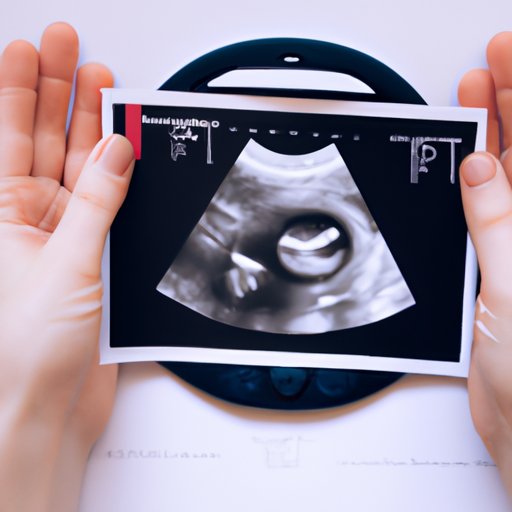
Introduction
The journey of pregnancy involves various milestones and many women are overjoyed when they find out they are pregnant. However, determining the exact duration of a pregnancy can be challenging for many, especially those experiencing their first pregnancy. Accurate determination of pregnancy duration is important as it helps to monitor growth and development, ensure timely medical attention, and provide personalized support to expectant mothers. In this article, we will provide a comprehensive guide on how to calculate pregnancy as accurately as possible.
Step-by-Step Guide
The first step to calculating pregnancy is using the last menstrual period (LMP) date. Typically, a menstrual cycle lasts between 28 to 32 days, and ovulation occurs approximately two weeks after the commencement of the menstrual period. This is usually two weeks before conception occurs. To calculate pregnancy based on the LMP:
- Determine the first day of your last menstrual cycle.
- Add 280 days or 40 weeks to the date.
- The resulting date is your estimated due date (EDD).
It’s important to note that cycle length can vary from person to person, and this can affect the accuracy of the EDD obtained from this method. It’s also important to discuss any health concerns or issues with your doctor or midwife.
Due Date Calculator
To make things easier, you can use an interactive due date calculator to determine your EDD. These are usually available online and require you to input the date of your last menstrual period. Once you input the required date, the calculator will generate an estimated due date. It’s important to remember that the EDD provided may not be the exact date of birth, but it serves as an estimate to prepare for the baby’s arrival.
It’s important to note that due dates may be inaccurate, and only a small percentage of babies are born exactly on the EDD. The due date is merely an estimate based on the data available. It is important to keep in touch with your healthcare provider to ensure that you receive the best possible care throughout your pregnancy.
Trimester Breakdown
Trimesters are typically grouped into three three-month periods. Some people use different approaches to break down the pregnancy into trimesters. For the sake of this article, we will discuss this breakdown:
- First Trimester: This is the period between the first day of your last menstrual period and the twelfth week of pregnancy. During this time, the baby’s vital organs start developing, and women may experience symptoms such as morning sickness, fatigue, and mood swings. Women are advised to take regular prenatal vitamins and avoid smoking, drug use, and alcohol. They should also attend regular prenatal check-ups with their healthcare providers.
- Second Trimester: This is the period between the 13th and 28th week of pregnancy. During this time, the baby’s organs continue to develop, and the mother may begin to feel the baby move. Women still experience nausea and fatigue at times and will need an ultrasound to ensure the baby is healthy. Women may face a host of health issues, and they must discuss these concerns with healthcare providers.
- Third Trimester: This is the final leg of pregnancy, running from the 29th week until the baby is born. The developing fetus is now fully formed, but the baby still gains weight and stores fat. Women will experience more physical symptoms such as Braxton Hicks contractions, back pain, and pelvic pain. Attending regular antenatal check-ups is important during this period.
It’s important to note that the symptoms and experiences of pregnancy vary widely among women and that you should discuss any concerns or issues with your healthcare provider.
Ultrasound-Based Calculations
Ultrasound scans are a non-invasive way of determining fetal viability and gestational age. An ultrasound examination is usually carried out at around 20 weeks of pregnancy, but it can be performed earlier, especially in high-risk pregnancies. An ultrasound scan works by sending high-frequency soundwaves into the uterus and analyzing the echo they generate. The resulting image gives an accurate estimate of the baby’s gestational age and an estimate of the due date. This method is more accurate than LMP based calculations and is often used in cases where the due date is unknown.
Use of Pregnancy Wheels
A pregnancy wheel is a hand-held device used to calculate pregnancy duration. It is an analog device that operates on a similar principle to LMP-based calculations. The wheel consists of a circular diagram that has the LMP date as the starting point. The wheel has a movable overlay that is used to calculate the EDD. The benefit of a pregnancy wheel is that it’s portable and can be easily used by anyone. A drawback is that it’s not as accurate as ultrasound-based measurements.
Importance of Accurate Calculation
Accurate calculation of pregnancy duration is vital in ensuring proper medical care, meeting developmental milestones, and managing health risks. Knowing the exact duration helps healthcare providers prepare for the baby’s arrival and anticipate complication risk factors. Accurate pregnancy calculation helps women make informed decisions during the course of pregnancy. It is important to keep regular prenatal checkups and communicate any issues with healthcare providers who can help provide personalized care during pregnancy.
Conclusion
Calculating pregnancy duration is the foundation of providing high-quality prenatal care and ensuring the good health of both mother and child. Different methods are available to determine gestational age, but it is important to consult with healthcare providers to ensure accurate calculations. Accurate determination of gestational age will help provide personalized care and offer a stress-free pregnancy experience.
If you have any concerns or need further information, you can consult with your healthcare provider, check out informative websites or check out online support groups.




